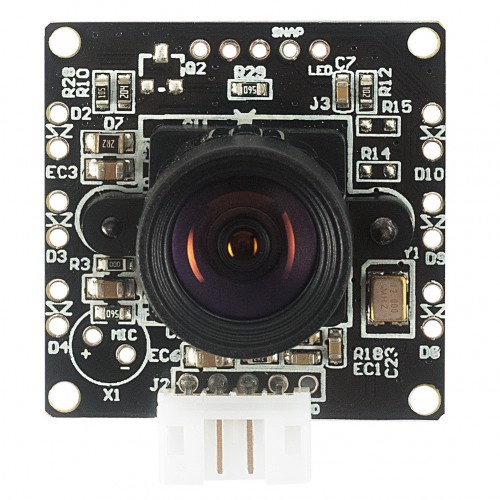A serial camera module is an excellent addition to a microcontroller project when anyone wants to take a photo or control a running video stream. This module has a few features built in, such as saturation, ability to change or adjust the brightness, hue of images, auto-brightness and auto-contrast adjustment, and motion detection.
The serial camera module was designed earlier for surveillance purposes and was meant to stream TV-resolution video and take commands from serial port.
This serial port commands can request that the module freezes the video and then downloads a JPEG colour image. Usually, it just displays video to a security monitor, and when the motion is detected, it takes a photo and saves it to a disc.
It is a high-resolution module, and the maximum size it can take is 640-480 pixels. The camera module is sensitive to infrared light, and this light alters the colour rendition. It is meant for surveillance and is the best module in the market. The module size is 32mm*32mm, and the image sensor is CMOS ¼ inch. The shutter is an electronic rolling shutter, and the exposure is automatic.
Inadequate availability of ample amount of light is one of the significant challenges in surveillance. It is a fact that it is all in the past, the images which were captured in low-lighting conditions were not visible properly. They had detail loss, and in today’s day and age, there are continuous improvements in sensor technology. This led to a massive demand for the low light serial jpeg camera.
What is low light, and what are the possible factors affecting it?
The ability of the camera to provide intelligible images even in extremely low light conditions by trying to preserve the details and minimise the noise in the output images is the low light performance. The low light serial jpeg camera gives images that are high quality in low lighting conditions.
Given below are some of the factors that contribute to the light performance of a camera-
- The pixel size.
- Lens aperture.
- Sensitivity.
- Signal-to-noise ratio.
Pixels
Pixels are the square Wells which collect photons, and the pixel size refers to the overall dimension of the square well. It is one of the most critical factors which is considered when choosing a camera for low-light applications.
Lens aperture
It determines the quantity of light which falls on the sensor.
Sensitivity.
It is an indicator of the ability of an image sensor to convert the incident photon energy to electrical signals.
SNR.
The ratio of valid image data to invalid image data is called SNR.


No comments yet